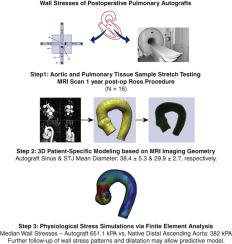The Journal of Thoracic and Cardiovascular Surgery ( IF 6 ) Pub Date : 2021-08-31 , DOI: 10.1016/j.jtcvs.2021.08.058 Yue Xuan 1 , Edgardo Alonso 1 , Alexander Emmott 2 , Zhongjie Wang 1 , Shalni Kumar 1 , Francois-Pierre Mongeon 3 , Richard L Leask 2 , Ismail El-Hamamsy 4 , Liang Ge 1 , Elaine E Tseng 1

|
Objective
The Ross procedure is an excellent option for children or young adults who need aortic valve replacement because it can restore survival to that of the normal aged-matched population. However, autograft remodeling can lead to aneurysmal formation and reoperation, and the biomechanics of this process is unknown. This study investigated postoperative autograft remodeling after the Ross procedure by examining patient-specific autograft wall stresses.
Methods
Patients who have undergone the Ross procedure who had intraoperative pulmonary root and aortic specimens collected were recruited. Patient-specific models (n = 16) were developed using patient-specific material property and their corresponding geometry from cine magnetic resonance imaging at 1-year follow-up. Autograft ± Dacron for aneurysm repair and ascending aortic geometries were reconstructed to develop patient-specific finite element models, which incorporated material properties and wall thickness experimentally measured from biaxial stretching. A multiplicative approach was used to account for prestress geometry from in vivo magnetic resonance imaging. Pressure loading to systemic pressure (120/80) was performed using LS-DYNA software (LSTC Inc, Livermore, Calif).
Results
At systole, first principal stresses were 809 kPa (25%-75% interquartile range, 691-1219 kPa), 567 kPa (485-675 kPa), 637 kPa (555-755 kPa), and 382 kPa (334-413 kPa) at the autograft sinotubular junction, sinuses, annulus, and ascending aorta, respectively. Second principal stresses were 360 kPa (310-426 kPa), 355 kPa (320-394 kPa), 272 kPa (252-319 kPa), and 184 kPa (147-222 kPa) at the autograft sinotubular junction, sinuses, annulus, and ascending aorta, respectively. Mean autograft diameters were 29.9 ± 2.7 mm, 38.3 ± 5.3 mm, and 26.6 ± 4.0 mm at the sinotubular junction, sinuses, and annulus, respectively.
Conclusions
Peak first principal stresses were mainly located at the sinotubular junction, particularly when Dacron reinforcement was used. Patient-specific simulations lay the foundation for predicting autograft dilatation in the future after understanding biomechanical behavior during long-term follow-up.
中文翻译:

早期重塑肺自体移植物的壁应力
客观的
Ross 手术对于需要主动脉瓣置换术的儿童或年轻人来说是一个极好的选择,因为它可以将生存率恢复到正常年龄匹配人群的水平。然而,自体移植物重塑可导致动脉瘤形成和再次手术,而这一过程的生物力学尚不清楚。本研究通过检查患者特定的自体移植物壁应力来研究 Ross 手术后术后自体移植物重塑。
方法
招募了接受过 Ross 手术并在术中收集了肺根和主动脉标本的患者。患者特定模型 (n = 16) 是使用患者特定材料特性及其在 1 年随访时电影磁共振成像中的相应几何形状开发的。重建用于动脉瘤修复和升主动脉几何形状的自体移植物 ± 涤纶,以开发特定于患者的有限元模型,该模型结合了通过双轴拉伸实验测量的材料特性和壁厚。使用乘法方法来解释体内磁共振成像的预应力几何。使用 LS-DYNA 软件(LSTC Inc, Livermore, Calif)对系统压力 (120/80) 进行压力加载。
结果
At systole, first principal stresses were 809 kPa (25%-75% interquartile range, 691-1219 kPa), 567 kPa (485-675 kPa), 637 kPa (555-755 kPa), and 382 kPa (334-413 kPa) at the autograft sinotubular junction, sinuses, annulus, and ascending aorta, respectively. Second principal stresses were 360 kPa (310-426 kPa), 355 kPa (320-394 kPa), 272 kPa (252-319 kPa), and 184 kPa (147-222 kPa) at the autograft sinotubular junction, sinuses, annulus, and ascending aorta, respectively. Mean autograft diameters were 29.9 ± 2.7 mm, 38.3 ± 5.3 mm, and 26.6 ± 4.0 mm at the sinotubular junction, sinuses, and annulus, respectively.
Conclusions
第一主应力峰值主要位于窦管交界处,尤其是在使用涤纶加固时。在了解长期随访期间的生物力学行为后,针对特定患者的模拟为预测未来的自体移植扩张奠定了基础。

























 京公网安备 11010802027423号
京公网安备 11010802027423号